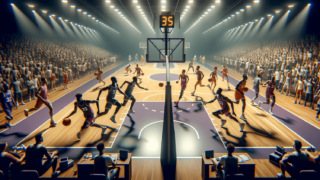
Out-of-Bounds Rule in Basketball: How It Works
Written by: Basketball Universe
Last updated:

Ever watched an intense basketball game when a player seems to defy gravity, leaping to save a ball from skirting out of bounds? In moments like these, the out-of-bounds rule comes into play and can make or break a team’s performance. For those who want to swish through the nitty-gritty of one of basketball’s most critical aspects, you’ve come to the right place. In this blog post, we’ll dunk into the heart of the out-of-bounds rule, discuss its history, and explore the fundamental principles you need to master the art of toeing the line. So lace up and let’s dive in!
Out-of-Bounds Rule in Basketball: How It Works
The out-of-bounds rule in basketball is implemented when the ball or a player in contact with the ball touches or crosses the boundary lines surrounding the court. When this occurs, possession is given to the opposing team, who will then inbound the ball from the nearest sideline or baseline. The rule’s objective is to ensure fair play and maintain the game’s fast pace within the designated playing area.
Out-of-bounds rule: A Historical Glance
You may be surprised to learn that the out-of-bounds rule in basketball is as old as the game itself. Dr. James Naismith, the inventor of basketball, included the rule in his original 13 rules in 1891. Of course, the game has evolved since then, and so have the specifications of the rule. Understanding the history and progression of the out-of-bounds rule provides valuable context on the core aspects of today’s basketball rules.
Breaking Down the Out-of-Bounds Rule in Detail
No one wants to be the player who accidentally steps on the line or fumbles the ball out of bounds during a heated game. However, grasping the out-of-bounds rule in depth can help you up your game and improve your team’s performance. Here, we’ll dive into different aspects of the out-of-bounds rule, so you are well-equipped to make those split-second decisions on the court.
Boundary Lines and Court Setup
Before we delve into the specifics, let’s clarify what defines the out-of-bounds zone. The basketball court is composed of two sidelines (longer) and two baselines or endlines (shorter) that demarcate its boundaries. The lines themselves are considered out-of-bounds, and any part of the player’s body or the ball that touches them or the area beyond them results in an out-of-bounds violation.
Determining Possession
When an out-of-bounds violation occurs, possession is awarded to the opposing team. They will inbound the ball from the sideline or baseline nearest to where the ball exited the court. This decision process is typically handled by the officials during the game. It’s crucial for players to be aware of their position on the court to avoid unnecessary turnovers and help their team maintain possession.
Exceptions to the Rule
Some exceptions to the out-of-bounds rule can impact possessions and gameplay. Here are the essential ones to keep in mind:
- Jump Balls: If a held ball situation occurs near the boundary and both players touch the lines simultaneously, a jump ball will be called instead of an out-of-bounds violation.
- Deflections: A deflection occurs when a player touches the ball without fully gaining possession, and the ball goes out of bounds. In such instances, possession remains with the team who previously had the ball.
- Fouls: If a foul occurs that causes the ball or the player in possession of the ball to go out-of-bounds, the team who was fouled will retain possession of the ball.
Key Strategies to Prevent Out-of-Bounds Violations
Now that we’ve unraveled the intricacies of the out-of-bounds rule, it’s time to put that knowledge to use. The following strategies can help players avoid the most common out-of-bounds mistakes and maintain their offensive momentum.
Stay Aware of Your Court Positioning
Proper court position awareness is crucial for both individual players and the team as a whole. Knowing where you are on the court can prevent unnecessary out-of-bounds violations and turnovers. Players can develop this skill with practice, repetition, and the guidance of their coaches.
Master the Art of Saving Loose Balls
Loose balls are a common cause of out-of-bounds violations. However, players can hone their skills in saving loose balls by practicing dives, jumps, and hand-eye coordination exercises. Not only can these skills help prevent turnovers, but they can also contribute to thrilling game-saving moments on the court.
Communicate Effectively with Teammates
Effective communication on the court is one of the most critical aspects of high-level basketball play. Players who are aware of their teammates’ positions and communicate essential information can significantly reduce the likelihood of out-of-bounds violations. Regular team practice sessions and drills can help develop this team chemistry.
Understanding Officials’ Roles in Calling Out-of-bounds Plays
Game officials play a substantial role in enforcing the out-of-bounds rule and ensuring a fun and fair game for all participants. It’s essential to have a clear understanding of how officials make their out-of-bounds calls to avoid contentious moments and improve game flow.
Official Signals for Out-of-bounds
When a violation occurs, the official will blow their whistle and extend their arm in the direction of the sideline or baseline where the ball went out. Next, they will signal which team has possession by pointing towards their designated basket.
Challenging Officials’ Decisions
If a team captain believes that the official made an incorrect out-of-bounds call, they can respectfully address the official and request a review of the play. It’s crucial to remain composed and professional during these exchanges, as unsportsmanlike conduct can result in penalties for the team.
Exploring Out-of-Bounds Rule Variation Across Different Basketball Levels
While the out-of-bounds rule maintains its basic principles across all levels of the game, some variations exist across amateur, collegiate, and professional leagues. Familiarizing yourself with these differences is vital to ensure seamless transition and adaptation to different rule sets.
NCAA Basketball
In NCAA basketball, the out-of-bounds rule is mostly similar to professional basketball, with only minor differences in possession after missed free throws and technical fouls. Players should consult their respective league rulebooks to ensure they understand these subtleties and avoid any confusion during games.
FIBA International Basketball
The International Basketball Federation (FIBA) enforces slightly different rules for out-of-bounds possessions, particularly concerning restart scenarios and end-line violations. As with the NCAA, players should be aware of these differences when preparing for international competition.
Amateur and Youth Basketball
At the youth level, the out-of-bounds rule upholds the same core principles, but there may be slight variations in official signals, court dimensions, and boundary lines depending on the age group and specific league structure. Players, coaches, and parents should familiarize themselves with their league’s guidelines to enhance their basketball experience and understanding of the game.
In conclusion, having a comprehensive understanding of the out-of-bounds rule in basketball can significantly improve players’ performance and overall enjoyment of the game. By mastering this critical component of basketball, players will be more confident on the court, leading to more impressive play and a deeper appreciation for the sport’s intricacies. So, let’s get out there, and up our basketball rules knowledge to become the best player we can be!
Additional Insight into Out-of-Bounds Situations and Tactics
Having touched upon every important aspect of the out-of-bounds rule in basketball, let’s dive into some additional insights and tactics that can help elevate a player’s game even further. By mastering these advanced ideas, you’ll find yourself well equipped for those tense on-court situations that could result in an out-of-bounds violation or other unfavorable outcomes.
Crucial Out-of-Bounds Scenarios
While the fundamentals of the out-of-bounds rule can help you understand the basics, some strategic thinking can provide you with the upper hand in various critical scenarios. Let’s explore some commonly faced situations that require a deeper understanding of the out-of-bounds rule.
Taking Charges Near Out-of-Bounds Lines
Defensive players can work on their skills in taking charges close to the out-of-bounds lines. A charge is a powerful defensive play that results in an offensive foul, thus creating a turnover. By practicing taking charges in proximity to the out-of-bounds lines, players effectively learn how to defend shots without causing out-of-bounds violation themselves.
Forcing an Opponent Towards the Boundary
An effective strategy to reduce an opponent’s options during a drive to the basket is ‘channeling,’ which involves guiding them towards the out-of-bounds line. This tactic narrows their possible moves on the way to the hoop, increasing the chances of a turnover. Players who can master this technique and effectively use the out-of-bounds lines to their advantage are highly valuable on the defensive end of the game.
Pressuring Inbounds Passes
Following an out-of-bounds violation, the opposing team will need to make an inbounds pass. To capitalize on this situation, players can practice their defensive skills in creating pressure on the inbound passer. By making it challenging to complete a successful pass in the allowable five seconds, players can force a turnover or potentially create a bad pass that leads to an interception.
Inbounds Strategies and Tactics
One often overlooked consequence of the out-of-bounds rule is the necessity of inbounds plays. Coaches and players need to be aware of inbounds strategies and tactics, which can significantly impact a team’s offensive flow and overall game performance.
Creating Space and Timing Your Move
When executing an inbounds play, creating space and timing your move are crucial to a successful execution. Players need to use well-coordinated screens and movements to create open passing lanes and options for the inbound passer. Practicing these plays can lead to high-quality shot opportunities and ensure continuity in a team’s offense.
Quick Inbounds Passes
The speed of an inbounds pass can catch the defense off guard, providing the offense with an opportunity to score. It is important for players to practice their quick inbounds passes and ensure these passes are accurate and effective in beating the defense.
Utilizing Set Plays Off Inbounds
Coaches can design set plays specifically for inbounds situations to exploit defensive weaknesses and create high-scoring opportunities. These plays are integral to maintaining a team’s offensive momentum and should be practiced regularly by the team.
The mastery of these advanced tactics and strategies involving the out-of-bounds rule can significantly elevate a team’s performance on the court. Incorporating such nuances into a player’s game can undoubtedly help them stand out, proving that the understanding of the out-of-bounds rule goes far beyond merely grasping its basics.
Frequently Asked Questions (FAQ)
We understand that the out-of-bounds rule encompasses numerous details, strategies, and implications. To address any lingering questions, we have compiled a list of common queries related to this topic, complete with concise answers to help you truly understand this critical aspect of the game.
1. Can a player jump from out-of-bounds to save the ball?
Yes, a player can jump from out-of-bounds to save the ball as long as they establish both feet inbounds before making contact with the ball, and they don’t touch the boundary lines or the out-of-bounds area while they have possession of the ball.
2. Who gets possession after a ‘held ball’ situation?
After a held ball situation, possession is determined by the possession arrow or the alternating possession rule. The team indicated by the arrow will receive possession, and afterwards, the arrow will switch direction to indicate the other team for the next held-ball scenario.
3. If the out-of-bounds lines aren’t marked, how does a player know their position on the court?
In situations where the out-of-bounds lines aren’t clearly marked, players should rely on communication with their teammates, coaches, and officials to help navigate their on-court position. Additionally, players can familiarize themselves with the dimensions of the court to assist them in maintaining a mental boundary during gameplay.
4. What happens if the inbounder steps on or crosses the sideline or baseline when making a pass?
If the inbounder steps on or crosses the sideline or baseline while making an inbounds pass, it is considered an out-of-bounds violation, leading to a turnover. The ball will be awarded to the opposing team for a new inbounds play.
5. Can a defensive player reach over the out-of-bounds line to steal the ball during an inbounds play?
No, a defensive player cannot reach over the out-of-bounds line to steal the ball during an inbounds play. Doing so will result in a technical foul being called against the defensive player, granting the opposing team one free throw and retaining possession of the ball.
6. Can an inbounder bounce the ball off an opponent and regain possession on the court?
Yes, an inbounder can bounce the ball off an opponent and regain possession on the court, provided that the ball bounces off a part of the opponent’s body that is within the court boundaries.
7. Can the ball graze the top of the backboard without being considered out-of-bounds?
Yes, the ball can graze the top of the backboard without being considered out-of-bounds, as long as it doesn’t touch any support poles, cables, or any objects behind the backboard. If it touches any of these, it will be ruled out-of-bounds.
8. How much time does a player have to inbound the ball?
A player has five seconds to inbound the ball, starting from the moment they gain possession of the ball and the referee starts the count. If a player fails to pass the ball within this timeframe, a five-second violation occurs, resulting in a turnover.
9. Can a player call a timeout while touching the out-of-bounds lines or while in the out-of-bounds area?
No, a player cannot call a timeout while touching the out-of-bounds lines or while in the out-of-bounds area. To request a timeout, the player must have both feet inbounds and have full control of the ball.
10. What is the consequence of an out-of-bounds violation with less than two minutes remaining in the game?
If an out-of-bounds violation occurs with less than two minutes remaining in the game, it may trigger an automatic review by the game officials to determine possession. This review process is in place to ensure accurate calls are made during critical moments in the game.
Featured Posts
- No pillar pages found.




